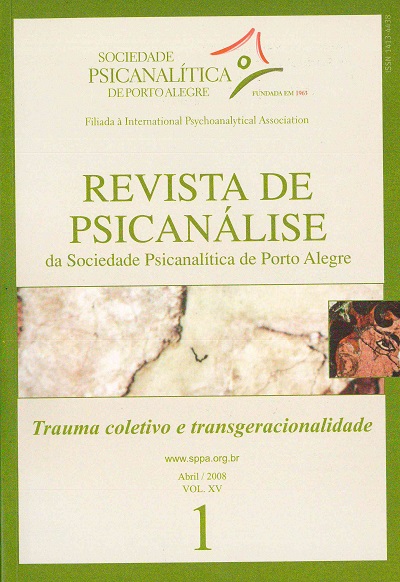Recordação, trauma e memória coletiva: a luta pela recordação em psicanálise
Palabras clave:
Trauma, Recordação, Status de verdade das recordações. Reconstrução. Memória coletiva, Holocausto, Dinâmica transgeracionalResumen
Na atual teoria da clínica psicanalítica, a recordação e a reconstrução do passado têm perdido a função terapêutica central que tiveram para Freud. O autor descreve essa evolução e mostra como o trauma e sua recordação resistiram a ela. Discute o problema do status de verdade das recordações. As recordações traumáticas não estão sujeitas à transformação pelo presente, quando recuperadas. Elas constituem um tipo de corpo estranho no tecido associativo psíquico e, em vez de formar réplicas exatas do evento traumático, estão expostas a remodelagens específicas. O autor descreve alguns dos processos psíquicos dessa área dissociada. A resolução da dinâmica que predomina nessa área encapsulada e a separação entre a fantasia e a realidade traumática requerem a recordação e a reconstrução dos eventos traumáticos no tratamento analítico. O autor prossegue descrevendo a importância vital, tanto para o indivíduo envolvido como para a sociedade, do discurso social relativo à verdade histórica dos assim chamados man made disasters. Freqüentemente, a relutância em conhecer resulta do desejo de evitar confrontar-se com os crimes, o horror e o sofrimento das vítimas. No Holocausto, em particular, surge o problema de como evitar que a descrição histórica em categorias definidoras elimine o horror e a natureza traumática do evento. Relembrar crimes envolve uma dinâmica particular. O autor descreve esta dinâmica e os seus efeitos transgeracionais na sociedade alemã do pós-guerra. Conclui que, para confrontar os problemas apresentados por uma realidade traumática multifacetada, é também necessário lutar para restaurar novamente a memória em um lugar apropriado na psicanálise (AU)
Descargas
Citas
ABRAHAM, N. (1978). Aufzeichnungen über das Phantom. Ergänzungen zu Freuds Metapsychologie. Psyche- Z Psychoanal. v. 45, p. 691-698, 1991.
ARLOW, J. (1991). Methodology and reconstruction. Psychoanal. Quart. v. 60, p. 539-563.
ASSMANN, A. (1998). Stabilisatoren der Erinnerung – Aff ekt, Symbol, Trauma. In: RÜSEN, J.; STRAUB J. (Ed.): Die dunkle Spur der Vergangenheit: psychoanalytische Zugänge zum Geschichtsbewußtsein. Erinnerung, Geschichte, Identität 2. Frankfurt: Suhrkamp. p. 131-152.
BALINT, M. (1969). Trauma and object relationship. Int. J. Psychoanal.. v. 50, p. 429-436.
BARANGER, M.; BARANGER,W.; MOM, J. (1988). The infantile trauma from us to Freud: pure trauma, retroactivity and reconstruction. Int. J. Psychoanal. v. 69, p. 113-128.
BERG, N. (2003). Der Holocaust und die westdeutschen Historiker. Erforschung und Erinnerung. Göttingen: Wallstein.
BIRKSTED-BREEN, D. (2003). Time and the après-coup. Int. J. Psychoanal. v. 84, p. 1501-1515.
BLUM, H. (1994). Reconstruction in psychoanalysis: childhood revisited and recreated. Madison: Int. Univ.Press.
____. (2003). Psychoanalytic controversies: repression, transference and reconstruction. Int. J. Psychoanal. v. 84, p. 497-513.
BOHLEBER, W. (2000). Die Entwicklung der Traumatheorie in der Psychoanalyse. Psyche-Z Psychoanal. v. 54, p. 797-839.
BOLL, F. (2001). Sprechen als Last und Befreiung. Holocaust Überlebende und politisch Verfolgte zweier Diktaturen. Ein Beitrag zur deutsch-deutschen Erinnerungskultur. Bonn: J. H. W. Dietz.
BRENNEIS, C. B. (1999). The analytic present in psychoanalytic reconstructions of the historical past. J. Amer. Psychoanal. Assn. v. 47, p. 187-201.
DOMANSKY, E. (1993). Die gespaltene Erinnerung. In: KOEPPEN, M. (Ed.). Kunst und Literatur nach Auschwitz. Berlin. p. 178-196.
COHEN, J. (1985). Trauma and repression. Psychoanal. Inquiry. v. 5, p. 163–189.
FONAGY, P (1999). Memory and therapeutic action. Int. J. Psychoanal. v. 80, p. 215-223.
_____. (2003). Psychoanalytic controversies. Rejoinder to Harold Blum. Int. J. Psychoanal. v. 84, p. 503-509.
FREEMAN, M. (1984). Psychoanalytic narration and the problem of historical knowledge. Psychoanal. Contemp. Thought. v. 7. p. 133-182.
FREUD, S. (1895d). Studien über Hysterie. In: G. W. v. 1, p. 75-312.
____. (1899a). Über Deckerinnerungen. In: G. W. v. 1, p. 465-488.
____. (1900a). Die Traumdeutung. In: G. W. v. 1/2.
____. (1909d). Bemerkungen über einen Fall von Zwangsneurose. In: G. W. v. 7, p. 379-463.
____. (1914g). Erinnern, Wiederholen und Durcharbeiten. In: G. W. v. 10, p. 126-136.
____. (1916-17a). Vorlesungen zur Einführung in die Psychoanalyse. In: G. W. v. 11.
____. (1920g). Jenseits des Lustprinzips. In: G. W. v. 13, p. 1-69.
____. (1923b). Das Ich und das Es. In: G. W. v. 13, p. 237-289.
____. (1926d). Hemmung, Symptom und Angst. In: G. W. v. 11, p. 21-115.
____. (1937d). Konstruktionen in der Analyse. In: G. W. v. 16, p. 43-56.
____. (1950). Briefe an Wilhelm Fliess: 1887–1904. In: MASSON, J. (Ed.). Bearbeitung der dt. Fassung. Frankfurt am Main: Fischer, 1986, p. 269.
FRIEDLÄNDER, S. (1997). Nazi Germany and the Jews – v. 1: the years of persecution 1933-1939. New York: Harper Collins.
GABBARD, G.; WESTEN, D. (2003). Rethinking the therapeutic action. Int. J. Psychoanal. v. 84, p. 823-841.
GAENSBAUER, T. (1995). Trauma in the preverbal period. Psychoanal. Study Child. v. 50, p. 122-149.
GRAND, S. (2000). The reproduction of evil: a clinical and cultural perspective. Hillsdale: Analytic Press.
GRANZOW, S. (1994). Das autobiographische Gedächtnis. Kognitionspsychologische und psychoanalytische Perspektiven. München: Quintessenz.
GREEN, A. (2002). Time in psychoanalysis: some contradictory aspects. London: Free Associations.
HOCK, U. (2003). Die Zeit des Erinnerns. Psyche-Z Psychoanal. v. 57, p. 812-840.
JOSEPH, B. (1985). Transference: the total situation. Int. J. Psychoanal. v. 66, p. 447-454.
JUREIT, U.; WILDT, M. (2005). Generationen. Zur Relevanz eines wissenschaft lichen Grundbegriffs. Hamburg: Hamburger Edition.
KENNEDY, R. (2002). Psychoanalysis, history, and subjectivity. London: Routledge.
KIHLSTROM, J. (2006). Trauma and memory revisited. In: UTTL, B.; OHTA, N.; SIEGENTHALER, A. (Ed.): Memory and emotions: interdisciplinary perspectives. New York: Blackwell.
KIRSHNER, L. (1994). Trauma, the good object and the symbolic: a theoretical integration. Int. J. Psycho-Anal. v. 75, p. 235-242.
KLUFT , R. (1999). Memory (Book reviews). J. Amer. Psychoanal. Assn. v. 47, p. 227-236.
KNIGGE, V.; FREI, N. (2002). Verbrechen erinnern. Die Auseinandersetzung mit Holocaust und Völkermord. München: Beck.
KRIS, E. (1956). The recovery of childhood memories in psychoanalysis. Psychoanal. Study Child. v. 11, p. 54-88.
LANGER, L. (1995). Memory’s time: Chronology and duration in Holocaust testimonies. In: . Admitting the Holocaust: Collected papers. New York: John Hopkins Univ. Press. p. 13-23.
LANSKY, M. (1995). Post-traumatic Nightmares. Psychodynamic Explorations. Hillsdale: Analytic Press.
LAPLANCHE, J.; PONTALIS, J.-B. (1967). The language of psychoanalysis. New York: Norton. 1973.
____. (1970). Leben und Tod in der Psychoanalyse. Olten und Freiburg: Walter, 1974.
____. (1992). La révolution copernicienne inachevée. Paris: Editions Aubier.
LAUB, D.; AUERHAHN, N. (1993). Knowing and not knowing massive psychic trauma: forms of traumatic memory. Int. J. Psychoanal. v. 74, p. 287-302.
LAUB, D.; PODELL, D.(1995). Art and Trauma. Int. J. Psycho-Anal. v. 76, p. 991-1005.
LEUZINGER-BOHLEBER, M.; PFEIFF, R. (2002): Remembering a depressive primary object. Memory in the dialogue between psychoanalysis and cognitive science. Int. J. Psychoanal. v. 83, p. 3-33.
LEYS, R. (2000). Trauma: a genealogy. Chicago: Chicago Univ. Press.
LOFTUS, E.; KETCHAM, K. (1994). The myth of repressed memory. New York: St. Martin’s Griffin.
MCNALLY, R. (2003). Remembering trauma. Cambridge: Harvard Univ. Press.
____. (2005). Debunking myths about trauma and memory. Can. J. Psychiatry. v. 50, p. 817-822.
MERRIDALE, C. (2001). Night of stone – death and memory in Russia. London: Granta Publications.
MITSCHERLICH, A. U. M. (1967). Inability to mourn: principles of collective behavior. New York: Grove Press 1975.
MOORE, R. (1999). The creation of reality in psychoanalysis: a view of the contributions of Donald Spence, Roy Schafer, Robert Stolorow, Irwin Z. Hoff man, and beyond. Hillsdale: The Analytic Press.
OLINER, M. (1996). External reality: The elusive dimension of psychoanalysis. Psychoanal. Quart. v. 65, p. 267-300.
PERSON, E.; KLAR, H. (1994). Establishing trauma: The difficulty distinguishing between memories and fantasies. J. Amer. Psychoanal. Assn. v. 42, p. 1055-1081.
PUGH, G. (2002). Freud’s “Problem”: cognitive neuroscience & psychoanalysis working together on memory. Int. J. Psychoanal. v. 83, p. 1375-1394.
QUINDEAU, I. (2004). Spur und Umschrift. Die konstitutive Bedeutung von Erinnerung in der Psychoanalyse. München: Wilhelm Fink.
RIESENBERG MALCOLM, R. (1988). Deutung: Die Vergangenheit in der Gegenwart. In: BOTT SPILLIUS, E. (Ed.). Melanie Klein heute. Bd. 2: Anwendungen. München: Verlag Internationale Psychoanalyse, 1991. p. 101-122.
RÜSEN, J. (2001). Zerbrechende Zeit. Über den Sinn der Geschichte. Köln: Böhlau.
SANDLER, J.; SANDLER, A. (1998). Internal objects revisited. London: Karnac.
SCHACTER, D. (1996). Searching for memory: the brain, the mind, and the past. New York: Basic Books.
____. (2001). The seven sins of memory: how the mind forgets and remembers. New York: Houghton Mifflin.
SCHAFER, R. (1982). The relevance of the‚here and now‘ transference interpretation to the reconstruction of early development. Int. J. Psychoanal. v. 63, p. 77-82.
SHEVRIN, H. (2002). A psychoanalytic view of memory in the light of recent cognitive and neuroscience research. Neuro-psychoanalysis. v. 4, p. 131-139.
SIMON, B. (1992). Incest – see under Oedipus complex: the history of an error in psychoanalysis. J. Amer. Psychoanal. Assn. v. 40, p. 955-988.
SOLOJED, K.(2006). Psychische Traumatisierung in den Familien von Opfern des Stalinismus. Psyche-Z Psychoanal. v. 60, p. 587-624. SPENCE, D. (1982). Narrative truth and historical truth: meaning and interpretation in psychoanalyis. New York: Norton.
STEELE, B. F. (1994). Psychoanalysis and the maltreatment of children. J. Amer. Psychoanal. Assn. v. 42, p. 1001-1025.
STERN, D. et al. (1998). Non-interpretive mechanisms in psychoanalytic therapy: the something more’ than interpretation. Int. J. Psychoanal. v. 79, p. 903-921.
VAN DER KOLK, B.; MCFARLANE, A.; WEISAETH, L. (Ed.) (1996). Traumatic Stress: the effects of overwhelming experience on mind, body, and society. New York: Guilford Press.
VOLBERT, R. (2004). Beurteilung von Aussagen über Traumata. Erinnerung und ihre psychologische Bewertung. Bern: Huber.
WELZER, H. (2002). Das kommunikative Gedächtnis. Eine Theorie der Erinnerung. München: Beck.
Descargas
Publicado
Cómo citar
Número
Sección
Licencia
Atribuo os direitos autorais que pertencem a mim, sobre o presente trabalho, à SPPA, que poderá utilizá-lo e publicá-lo pelos meios que julgar apropriados, inclusive na Internet ou em qualquer outro processamento de computador.
I attribute the copyrights that belong to me, on this work, to SPPA, which may use and publish it by the means it deems appropriate, including on the Internet or in any other computer processing.
Atribuyo los derechos de autor que me pertenecen, sobre este trabajo, a SPPA, que podrá utilizarlo y publicarlo por los medios que considere oportunos, incluso en Internet o en cualquier otro tratamiento informático.










